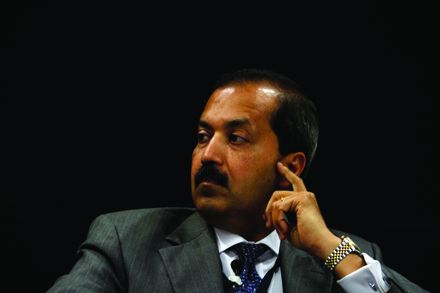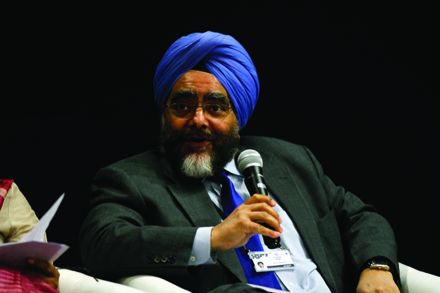To see the digital version of this report, please click here.
IFR: Sanjay, you were a banker for many years, what do you think of this and how are we making the infrastructure financing more attractive to equity investors?
<div class="inline_image_right inline_image" data-attachment="207900" style="width: 220px;"><p class="picture"><img alt="IFR Asia Funding India’s Infrastructure Roundtable 2013: Part 3" src="/MediaFiles/Browse/7a722740-3fb5-4942-9d7a-911cd90c086c"></p></div>Sanjay Nayar: I don’t think foreign money can help you with these problems. We’ve heard some terrific comments but the problems are all local. I think the stakeholders should get around the table and fix it. But, representing foreign money as I do in my new role, I want to give two perspectives.
“We have got the best EPC skills, project management skills, and we have put money in a project and it has got delayed, and the biggest thing we are celebrating is the lighting of a boiler!”
One, let me make the controversial remark that I am not that sure that foreign money is necessarily chasing India. The world as a whole has got a lot of requirements. Every country, developed and developing, is building infrastructure. China has got a massive investment boom going on. It’s not easy to get money from very long-term sources overseas. That is one perspective.
The second perspective I want to give you is the reverse of it. We interact with very long-term money every week and I have been on the road quite a bit last year trying to raise an Asia fund for our firm, and there was an investor in town who actually met Sharmila as well. So, the other perspective is they are happy to come to India at any rate. So, the rate is not the critical thing. What they want is surety and consistency of legal framework. They believe tremendously in India’s project management and project skills but the surety of getting a project on stream is very critical and a lot of things get covered here. The other thing they want to see and the feedback we keep getting is this: do you have a local takeout market, a local corporate bond market?
There is a lot of love for India. Money will come, and interest rates are a lower level criteria than some of the others that were discussed. I think it comes down to implementation.
We have put money in a project in India, a pretty sizeable amount and the reason we put it was an IPO didn’t take off. We underwrote expecting something like mid-teens and, at best, we’ll make probably 6%, if we are lucky.
Again, we are not hassled about it. We got tremendous experience in this project. And what did we learn? That nothing moves. Nothing moves, even when you actually begin to implement the project with an honest entrepreneur, no embezzlement, with serious guys and serious project management. When the damn generator is ready, the alternator is not ready, and between Trichy and Haridwar there is a debate going on: they can’t find the right route to move the generator to our power plant, which takes 57 days as it will uproot God knows how many railway crossings. It is an implementation nightmare, which as a banker I never learnt but as a private equity professional sitting in the board meetings it’s a terrible story.
So I would suggest, if I am allowed to be more controversial, that we should have a ministry of infrastructure. If you are really serious about it, then create an independent ministry under the finance ministry to pull all the stakeholders together and get things done. We have got equipment manufacturers here. We have got the best EPC skills, project management skills, and we have put money in a project and it has got delayed, and the biggest thing we are celebrating is the lighting of a boiler!
Foreign money loves India, but it cannot help you solve all the problems.
Sharmila Chavaly: In government, we are also aware of the problems that have risen in implementation. I think a lot of us in government – our finance minister has gone on record in saying this – envy the track record that the Chinese have in delivering a project on time and on cost.
Sanjay has suggested of having a ministry of infrastructure. The Cabinet Committee on Investment (CCI) was set up in December and has been a bit of game changer. I don’t know if many of you are aware but the eight weeks in which it has been set up to deal with projects, it has cleared US$14bn worth of investments. You may ask why were these US$14bn worth of projects delayed, but that is what happened. There have been delays because of environmental clearance issues. India has one of the most robust environmental and forest clearances systems in the world. This is of global standard. These were the major cause of the delays.
Now, the CCI has been set up so that when the investor comes in he is looking for a final decision in a finite time. If I take two to three years to say ‘yes’ or ‘no’, that’s not good for the investor. The CCI basically lays down a timeline for a decision. If environmental laws are going to be transgressed then no decision is given at that time. But if something is doable then that “yes” decision is taken. So, it has already started.
The other issue is what Arundhati has spoken about: the need to address the problems, including equity takeouts. You have to appreciate that the PPP scheme only really took off in the 2000s. In the road sector, which is the more mature sector, you will see that this is the sector where we have been making changes. The RBI, one of our most conservative institutions and one that has been proven to be right on many occasions, a month ago issued a clarification on the kind of securitised assets that road projects can have.
We appreciate that in a maturing landscape, and in certain sectors, we need to change. We need to take all the partners on board, and we have a federal system, which is a lot different from other countries.
Amit Kapur: When you are talking of assets worth US$5bn–$6bn, the stakes are very high. Let’s take a lesson we have learned from Dabhol Power, a 2000MW power plant. Today, when we stand after the takeover and dispute and the mothballing and resurrection, we have wiped out more than the original capital investment actually made. That is because the Rs65bn at risk and the rest of it was wiped out when it was taken over by NTPC and GAIL. So the issues of timely decisions and implementation versus the mothballing of an asset in an economical lifecycle are of vital importance. Things haves to be dealt with quickly, and now they are. Even the United States does not get a decision up to the Supreme Court in four years. We are doing it now and we are doing it regularly. A track record has been established where 90% of the cases coming to the regulator from an appellate body get disposed of within six months. And perhaps 5% or 10% go to the Supreme Court.
<div class="inline_image_right inline_image" data-attachment="207901" style="width: 220px;"><p class="picture"><img alt="IFR Asia Funding India’s Infrastructure Roundtable 2013: Part 3" src="/MediaFiles/Browse/666a0f66-b7cd-4128-8c31-daa6031274f1"></p></div>Pradeep Singh: I am glad the last few speakers have come back to the issues of implementation because that is where the rub really is. We need to be designing better planes and not just better parachutes. The fundamental issue is that we are, as a polity, quite prone to confusing the baby with the bath water.
“We seemed to have concluded that if 18 pairs of eyes look at the same case, we will get a better decision rather than having one pair of eyes. But the 18 pairs of eyes means 18 levels of decision-making, and all that results in delays.”
Take a few random examples. It is nobody’s case that the environment is not important. But what we are trying to say, as developers and as investors, is that the process by which environmental concerns are addressed is damaging and slowing the sector. We seemed to have concluded that if 18 pairs of eyes look at the same case, from the state government’s rain officer to the ministry of environment, we will get a better decision rather than having one pair of eyes. But the 18 pairs of eyes means 18 levels of decision-making, and all that results in delays.
Coming to contract flexibility, nobody’s saying contracts should not be treated with respect. But when we are talking about a 20 and 25-year project, the regulator and the policies and the government systems have to be equipped to deal with emerging realties. Many years ago, when the telecom licenses were issued we had bid them out on the basis of a licence fee, which was a fixed amount of money that the successful bidder was supposed to pay per annum. Everybody, the best and most sophisticated around the globe with their computer modelling, got that very wrong. They discovered very soon that the bids were very aggressive and there was no way they were going to meet that commitment. Thank God, at that time, the regulator decided to move – in violation of the contracts and in violation of the bid conditions – from a license to a revenue share, and a success story resulted from that.
As regards the role of state guarantees, we have developed a doctrine approach that the state government should not provide guarantees. I see the point, but the fact of the matter is that in PPPs the states have the role of market maker. Let there be a sunset clause of three years, four years, five years when this will go away. But, the states will have to step in and play a role.
And on cost recovery, once again, nobody’s saying that the poor should not get access to basic needs such as water or electricity. But that doesn’t mean that projects can be commercially unviable. That doesn’t mean the private sector must be kept out because they seek profit in commercial viability.
You’ve got to figure out what role the public sector can play in leveraging the private sector. Those are the kinds of issues where we need to make that distinction and truly create a public-private partnership and truly create a culture where implementation gets done.
Next: Part 4

